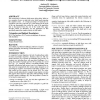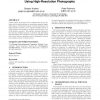ASSETS
2006
ACM
14 years 5 months ago
2006
ACM
The current state of software which targets older adults’ ability to use computers focuses on physical issues while largely ignoring the cognitive issues. As a larger percentage...
ASSETS
2006
ACM
14 years 5 months ago
2006
ACM
Visually impaired users are hindered in their efforts to access the World Wide Web (Web) because their information and presentation requirements are different from those of a sigh...
ASSETS
2006
ACM
14 years 5 months ago
2006
ACM
As ASSETS attendees, we are clearly interested in promoting accessibility in computing. One way to do this is to teach courses on the topic. Most such courses are aimed at upper-l...
ASSETS
2006
ACM
14 years 5 months ago
2006
ACM
The vast proliferation of GUI-based applications, including graphical interactive development environments (IDEs), has placed blind programmers at a severe disadvantage in a profe...
ASSETS
2006
ACM
14 years 5 months ago
2006
ACM
CopyCat is an American Sign Language (ASL) game, which uses gesture recognition technology to help young deaf children practice ASL skills. We describe a brief history of the game...
ASSETS
2006
ACM
14 years 5 months ago
2006
ACM
ASSETS
2006
ACM
14 years 5 months ago
2006
ACM
Many of today’s desktop applications are designed for use with a pointing device and keyboard. Someone with a disability, or in a unique environment, may not be able to use one ...
ASSETS
2006
ACM
14 years 5 months ago
2006
ACM
This paper describes iNetSim, a universally accessible network simulator, created to allow vision-impaired and sighted users to complete Cisco Certified Network Associate level tw...
ASSETS
2006
ACM
14 years 5 months ago
2006
ACM
Visual content in lectures can be enhanced for use by students with visual disabilities by using high-resolution digital still cameras. This paper presents a system which uses two...


